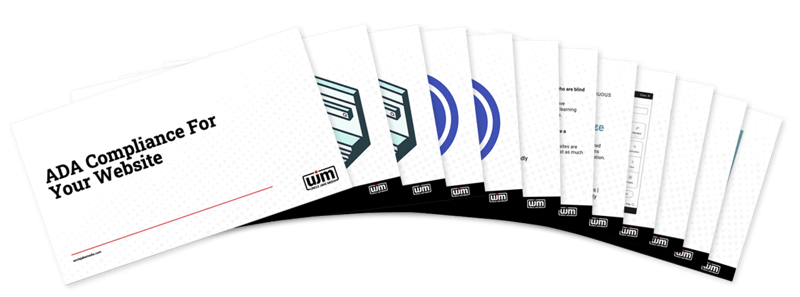
The Essentials of Website ADA Compliance

In the ever-evolving landscape of digital marketing, one term that's gaining increasing attention is "Website ADA Compliance." The Americans with Disabilities Act (ADA) emphasizes the importance of creating an inclusive online environment. This blog post delves into the essential aspects of Website ADA Compliance, offering insights, strategies, and a free resource to empower your team.
Understanding ADA Compliance: More Than a Legal Obligation
The Evolution of ADA in the Digital Age
As technology advances, so do the expectations for online accessibility. The ADA, enacted in 1990, initially focused on ensuring physical access for individuals with disabilities. However, in recent years, it has become more evident that online spaces need to be equally accessible.
The Significance of ADA Compliance for Websites
ADA Compliance for websites is not merely a legal obligation; it's a commitment to inclusivity. With an estimated 27% of U.S. adults having some form of disability, ensuring your website is accessible becomes paramount. It's not just about avoiding legal repercussions; it's about embracing a diverse audience and providing a seamless online experience for everyone.
Did you know that Google’s ranking algorithm now favors websites that are ADA-compliant? If you are working on building your digital presence and increasing organic traffic to your website, consider making your website compliant as a step in your Search Engine Optimization (SEO) strategy.
The Essentials of ADA Compliance
1. Navigable Website Structure
A well-structured website is the foundation of ADA compliance. Headings, lists, and a logical flow make it easier for screen readers to interpret content, enhancing the user experience for those with visual impairments.
2. Alternative Text for Images
Images speak volumes, but for those who rely on screen readers, they need descriptive alternative text (or “alt text”). Incorporating alt text ensures that all users, regardless of their abilities, can comprehend the content.

In the past alternative text has been a tool for making sure an image is optimized with search keywords to help a website rank higher on Google. While this is still helpful, making sure the alt text is also descriptive enough to provide the context of the image to vision-impaired users is more important. Combining the two strategies leads to better UI and search rank.
3. Captions and Transcripts for Multimedia
Multimedia elements, such as videos and podcasts, should be accompanied by captions or transcripts. This not only aids individuals with hearing impairments but also enhances the overall user experience.
4. Color and Contrast Considerations
Effective use of color contrast is essential for users with visual impairments. A website should be visually clear, making it easier for everyone to read and understand the content.
Why ADA Compliance Matters for Your Business
Legal and Ethical Considerations
Beyond legal obligations, embracing ADA Compliance aligns with ethical business practices. It showcases your commitment to inclusivity and positions your brand as one that values accessibility for all.
Improved User Experience
An ADA-compliant website isn't just for those with disabilities; it benefits every user. A well-structured, accessible website enhances user experience, leading to increased engagement and lead generation.
SEO Advantages
Search engines, like Google, prioritize accessible websites. By ensuring ADA Compliance, you not only cater to a wider audience but also boost your search engine rankings and widen your digital reach.
Empower Your Team with ADA Compliance Education
Keeping your team well-versed in the latest ADA regulations is crucial. Ensuring your website aligns with accessibility technology will help shape a future where the digital world is accessible to all.
Explore our ADA Compliance Overview Slide Deck designed to make educating your team a breeze. Equip your business with the knowledge and tools needed to prioritize ADA compliance for your website, fostering a more inclusive online experience.
The slide deck also includes a helpful look into how the Uncle Jake Media team helps implement ADA website compliance tools onto your website and how to get started.
Get Ready to Transform Your Website
Staying ahead of the curve is crucial, and making sure your website is ADA-compliant is one of many steps you can take to do so.
Let's ensure your website is not just compliant but truly exceptional in providing an accessible digital experience. Uncle Jake Media is your partner in navigating the digital frontier. Join us on this journey toward a more accessible and user-friendly online presence.
Schedule 15 minutes with Brady to discuss ADA compliance or any other challenges you are facing with your business’s digital presence.
Blog featured Image by storyset on Freepik



